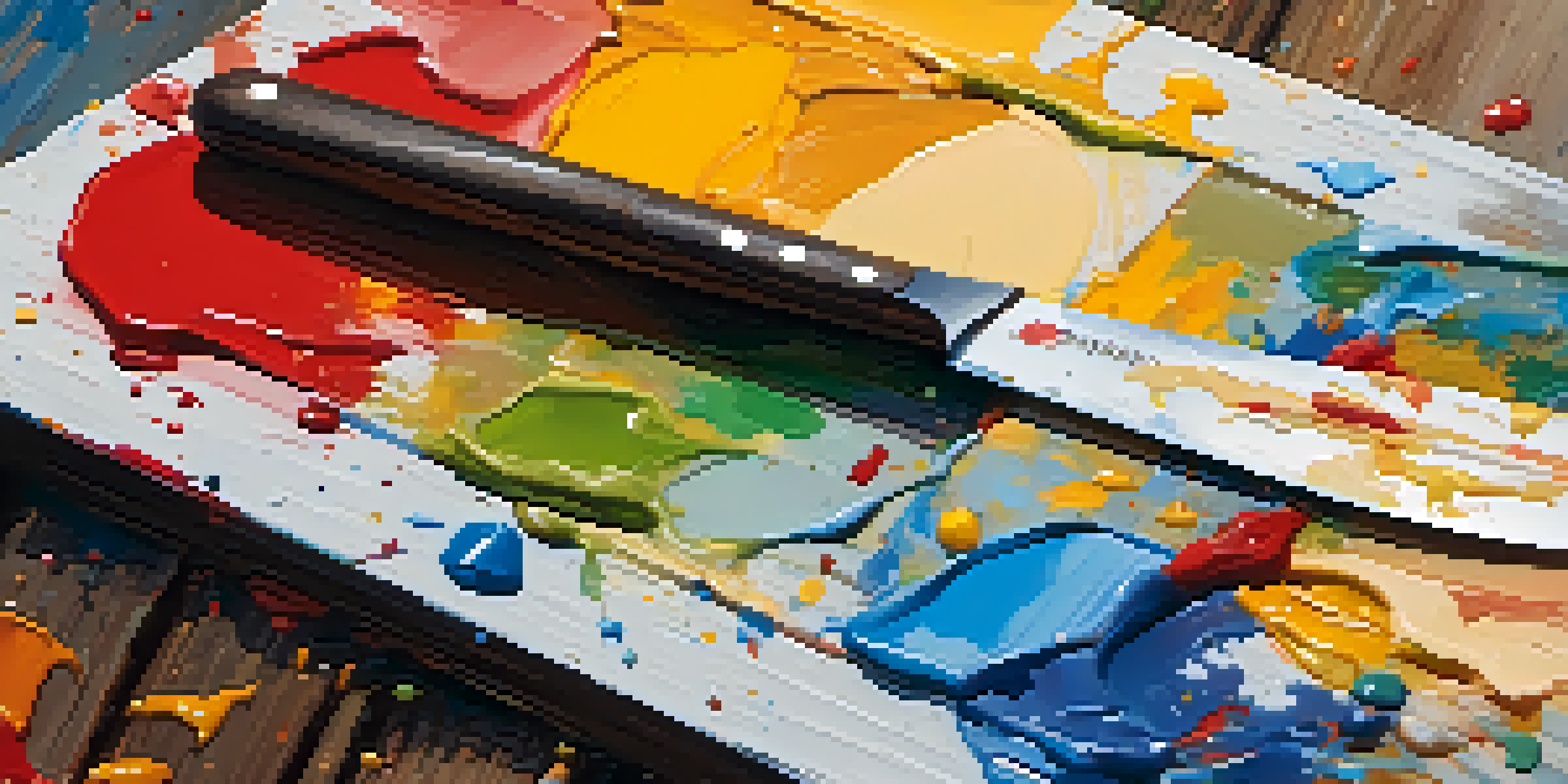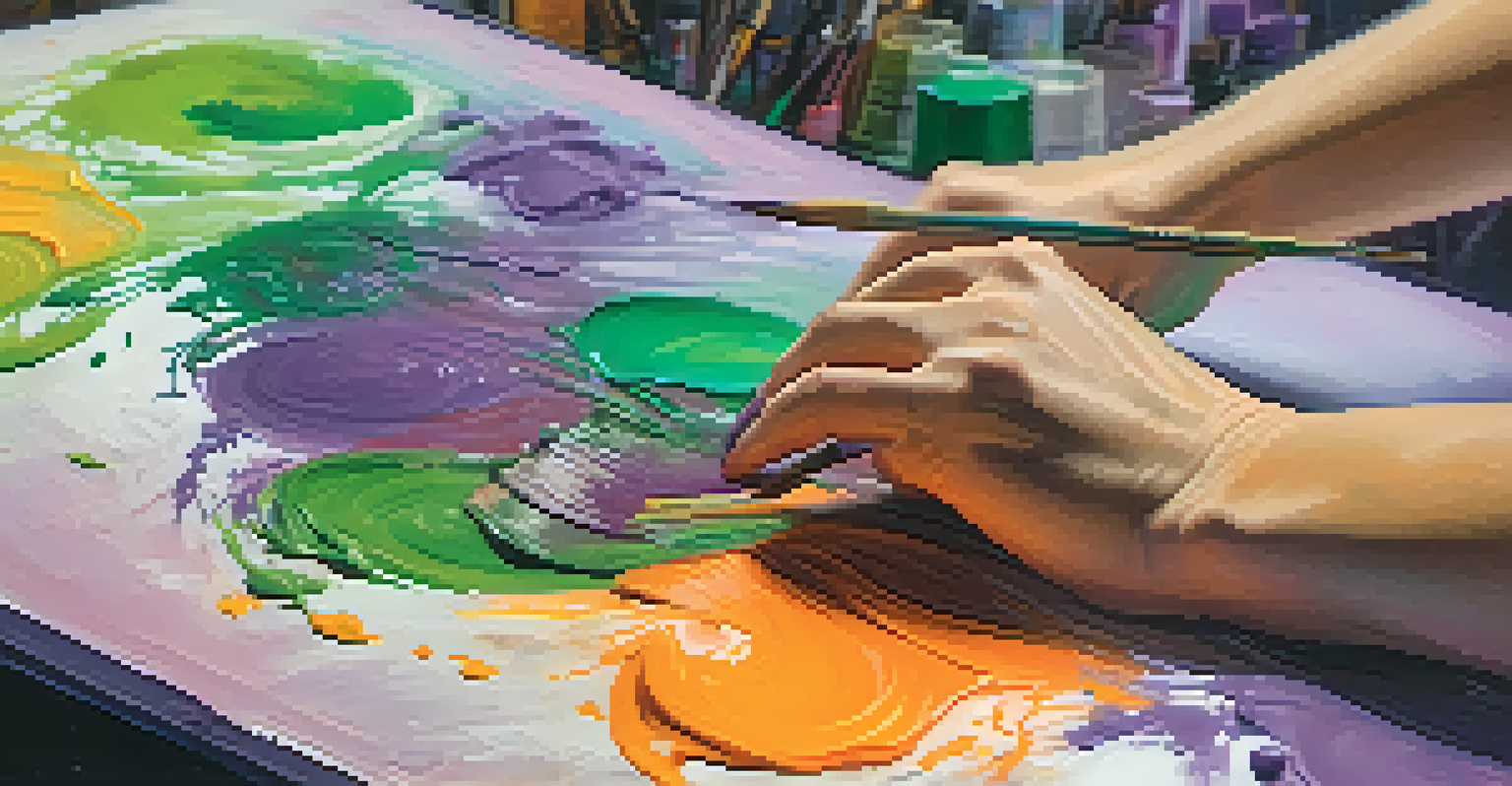Creating Texture with Palette Knives in Acrylic Painting

Understanding the Basics of Palette Knives
Palette knives are versatile tools that can dramatically change your acrylic painting experience. Unlike traditional brushes, they have a flat, blunt blade that can create a variety of textures. This unique design allows for smooth application of paint as well as the ability to scrape and layer colors, giving your artwork depth.
Every artist dips his brush in his own soul, and paints his own nature into his pictures.
When you first pick up a palette knife, you might feel like you're wielding a new kind of brush. The way you hold it and the angle at which you apply it can lead to different effects. Experimenting with your grip will help you discover the best techniques for your style.
Many artists find that using palette knives not only adds texture but also encourages spontaneity. The freedom that comes with this tool can lead to unexpected results that spark creativity. So, don’t be afraid to play around and see what you can create!
Choosing the Right Palette Knife for Your Project
There are various shapes and sizes of palette knives, each designed for specific tasks. For instance, a straight-edged knife is great for spreading paint, while a trowel-shaped knife can create thick textures and lines. Understanding the purpose of each shape will help you choose the right tool for your artistic vision.

As you start selecting your palette knife, consider the scale of your artwork. A larger knife may be more suitable for bigger canvases, while a smaller knife can help with fine details. It's also beneficial to have a few different types on hand to accommodate various techniques.
Palette Knives Enhance Texture
Using palette knives allows artists to create a variety of textures and spontaneous effects in their acrylic paintings.
Remember, the right palette knife can enhance your painting process. As you explore different knives, you'll develop a preference that complements your style, making it easier to create the textures you envision.
Preparing Your Canvas for Texture Techniques
Before diving into your painting, it's essential to prepare your canvas properly. A primed canvas provides a smooth surface for the palette knife, allowing for better paint adhesion and texture creation. Make sure your canvas is clean and free of dust to ensure optimal results.
The only way to do great work is to love what you do.
You might also want to experiment with different types of ground, such as gesso or acrylic mediums, to create unique textures. Applying a layer of modeling paste can add even more dimension to your work. The key here is to think ahead about how your preparation will influence your final piece.
Taking time to prepare your canvas can make a significant difference in your painting process. A well-prepped canvas allows the palette knife to glide smoothly, making it easier to achieve the desired texture and finish.
Layering Techniques for Depth and Dimension
Layering is a crucial technique when using palette knives to add depth to your acrylic painting. Start with a base layer of color and allow it to dry before applying additional layers. This way, you can build up texture without muddying the colors underneath.
As you layer, think about how different colors interact with each other. You can create visual interest by using contrasting colors or varying shades of the same hue. This approach not only enhances texture but also adds complexity to your piece.
Layering Adds Depth and Dimension
Layering colors with a palette knife not only builds texture but also enriches the visual complexity of the artwork.
Don’t hesitate to experiment with different layering techniques. For instance, you can apply a thick layer of paint, then use the knife to scrape and reveal the layers beneath, creating fascinating effects that capture the viewer's attention.
Incorporating Color Mixing with Palette Knives
Color mixing is another area where palette knives shine. Their flat surface allows you to blend colors directly on your palette or even on the canvas. This technique can lead to vibrant, rich tones that enhance the overall texture of your work.
When mixing colors with a palette knife, be mindful of the ratios and how they interact. A little experimentation can lead to beautiful results, such as creating a gradient effect or a mottled texture that adds depth to your composition.
By using a palette knife for color mixing, you not only save time but also create unique blends that are difficult to achieve with brushes. This method encourages exploration and can significantly elevate your painting game.
Creating Texture with Impasto Techniques
Impasto is a technique that involves applying paint thickly onto the canvas, creating a three-dimensional effect. Using a palette knife for impasto allows you to create bold, raised textures that can really make your artwork stand out. It’s like sculpting with paint!
When using the impasto technique, you can layer paints of different colors on top of each other without mixing them. This results in a dynamic visual experience, where the colors interact in fascinating ways. Think of it as building a landscape with peaks and valleys of paint.
Sealing Protects Your Artwork
Applying a sealant after painting safeguards your textures and enhances the overall finish of your masterpiece.
Mastering impasto with a palette knife takes practice, but the results are striking. Your paintings will gain a tactile quality that invites viewers not just to see, but to feel the texture and energy of your work.
Finishing Touches: Sealing Your Textured Painting
Once you’re happy with the textures you've created, it's time to protect your artwork. Sealing your acrylic painting is essential, especially if you've used techniques like impasto. A good varnish will safeguard your textures from dust, dirt, and fading over time.
When choosing a sealant, consider whether you want a matte or glossy finish. A matte varnish can soften the colors, while a glossy finish will enhance the vibrancy and depth of the textures. Test a small area first to see how the varnish affects your piece.

Applying a sealant not only protects your work but also brings a polished look to your painting. It’s the final step in your creative journey, ensuring that your textured masterpiece remains stunning for years to come.